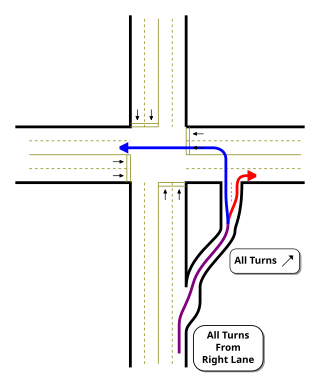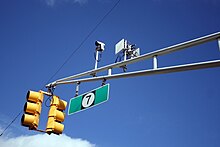
A high-occupancy vehicle lane is a restricted traffic lane reserved for the exclusive use of vehicles with a driver and at least one passenger, including carpools, vanpools, and transit buses. These restrictions may be only imposed during peak travel times or may apply at all times. There are different types of lanes: temporary or permanent lanes with concrete barriers, two-directional or reversible lanes, and exclusive, concurrent, or contraflow lanes working in peak periods.

Traffic lights, traffic signals, or stoplights – also known as robots in South Africa and Namibia – are signaling devices positioned at road intersections, pedestrian crossings, and other locations in order to control the flow of traffic.

Traffic signs or road signs are signs erected at the side of or above roads to give instructions or provide information to road users. The earliest signs were simple wooden or stone milestones. Later, signs with directional arms were introduced, for example the fingerposts in the United Kingdom and their wooden counterparts in Saxony.

A Jersey barrier, Jersey wall, or Jersey bump is a modular concrete or plastic barrier employed to separate lanes of traffic. It is designed to minimize vehicle damage in cases of incidental contact while still preventing vehicle crossovers resulting in a likely head-on collision. Jersey barriers are also used to reroute traffic and protect pedestrians and workers during highway construction. They are named after the U.S. state of New Jersey which first started using the barriers as separators between lanes of a highway in the 1950s.

A jughandle is a type of ramp or slip road that changes the way traffic turns left at an at-grade intersection. Instead of a standard left turn being made from the left lane, left-turning traffic uses a ramp on the right side of the road. In a standard forward jughandle or near-side jughandle, the ramp leaves before the intersection, and left-turning traffic turns left off of it rather than the through road; right turns are also made using the jughandle. In a reverse jughandle or far-side jughandle, the ramp leaves after the intersection, and left-turning traffic loops around to the right and merges with the crossroad before the intersection.

The Manual on Uniform Traffic Control Devices for Streets and Highways is a document issued by the Federal Highway Administration (FHWA) of the United States Department of Transportation (USDOT) to specify the standards by which traffic signs, road surface markings, and signals are designed, installed, and used. In the United States, all traffic control devices must legally conform to these standards. The manual is used by state and local agencies as well as private construction firms to ensure that the traffic control devices they use conform to the national standard. While some state agencies have developed their own sets of standards, including their own MUTCDs, these must substantially conform to the federal MUTCD.

The Federal Highway Administration (FHWA) is a division of the United States Department of Transportation that specializes in highway transportation. The agency's major activities are grouped into two programs, the Federal-aid Highway Program and the Federal Lands Highway Program. Its role had previously been performed by the Office of Road Inquiry, Office of Public Roads and the Bureau of Public Roads.
The Research and Innovative Technology Administration (RITA) is a unit of the United States Department of Transportation (USDOT). It was created in 2005 to advance transportation science, technology, and analysis, as well as improve the coordination of transportation research within the department and throughout the transportation community.
Signal timing is the technique which traffic engineers use to distribute right-of-way at a signalized intersection. The process includes selecting appropriate values for timing, which are implemented in specialized traffic signal controllers. Signal timing involves deciding how much green time the traffic signal provides an intersection by movement or approach, how long the pedestrian WALK signal should be, whether trains or buses should be prioritized, and numerous other factors.

Transportation demand management or travel demand management (TDM) is the application of strategies and policies to increase the efficiency of transportation systems, that reduce travel demand, or to redistribute this demand in space or in time.
The Sydney Coordinated Adaptive Traffic System, abbreviated SCATS, is an intelligent transportation system that manages the dynamic timing of signal phases at traffic signals, meaning that it tries to find the best phasing for a traffic situation. SCATS is based on the automatic plan selection from a library in response to the data derived from loop detectors or other road traffic sensors.
Vehicle infrastructure integration (VII) is an initiative fostering research and application development for a series of technologies directly linking road vehicles to their physical surroundings, first and foremost to improve road safety. The technology draws on several disciplines, including transport engineering, electrical engineering, automotive engineering, and computer science. VII specifically covers road transport, although similar technologies are in place or under development for other modes of transport. Planes, for example, use ground-based beacons for automated guidance, allowing the autopilot to fly the plane without human intervention. In highway engineering, improving the safety of a roadway can enhance overall efficiency. VII targets to improve both safety and efficiency.
The National Transportation Communications for Intelligent Transportation System Protocol (NTCIP) is a family of standards designed to achieve interoperability and interchangeability between computers and electronic traffic control equipment from different manufacturers.

The normal function of traffic lights requires more than sight control and coordination to ensure that traffic and pedestrians move as smoothly, and safely as possible. A variety of different control systems are used to accomplish this, ranging from simple clockwork mechanisms to sophisticated computerized control and coordination systems that self-adjust to minimize delay to people using the junction.

Smart traffic lights or Intelligent traffic lights are a vehicle traffic control system that combines traditional traffic lights with an array of sensors and artificial intelligence to intelligently route vehicle and pedestrian traffic. They can form part of a bigger intelligent transport system.
Sidra Intersection is a software package used for intersection (junction), interchange and network capacity, level of service and performance analysis, and signalised intersection, interchange and network timing calculations by traffic design, operations and planning professionals.
Urban freight distribution is the system and process by which goods are collected, transported, and distributed within urban environments. The urban freight system can include seaports, airports, manufacturing facilities, and warehouse/distribution centers that are connected by a network of railroads, rail yards, pipelines, highways, and roadways that enable goods to get to their destinations.

MASSTR, the' Meadowlands Adaptive Signal System for Traffic Reduction, is an adaptive traffic control system commissioned by the New Jersey Meadowlands Commission (NJMC) for a forty square mile region in the New Jersey Meadowlands. Adaptive Signal Control Technology (ASCT) adjusts the signal timings based upon the flow of traffic instead of utilizing fixed or actuated timings. This regional intelligent transportation system (ITS) incorporates more than 128 traffic signals and serves more than 400,000 vehicles daily. MASSTR is one of a number of ITS projects deployed throughout New Jersey. MASSTR is the fourth-largest deployment of SCATS in the United States.

A managed lane is a type of highway lane that is operated with a management scheme, such as lane use restrictions or variable tolling, to optimize traffic flow, vehicle throughput, or both. Definitions and goals vary among transport agencies, but managed lanes are generally implemented to achieve an improved operational condition on a highway, such as improving traffic speed and throughput, reducing air pollution, and improving safety. Types of managed lanes include high-occupancy vehicle (HOV) lanes, high-occupancy toll lanes, express toll lanes, reversible lanes, and bus lanes. Most managed lane facilities are located in the United States and Canada, although HOV and bus lanes can be found in many other countries; outside of the US and Canada, many countries use active traffic management that manage all lanes of a highway.

Automated Flagger Assistance Device (AFAD) is a specialized piece of safety equipment used in the traffic control industry on roadway work zones. AFADs were designed as an innovative solution to the dangers of traditional traffic control, aiming to increase the safely and efficiency of work zones. AFADs operate daily, short-term lane closure work zones and can work on a variety of job types including stationary jobs, intersections, mobile utility jobs, road construction jobs, among others. The Guardian SmartFlagger specifically, has been designed to work on 99% of jobsites with its compact design, 60 hour battery life, and 80 hours of recording. AFADs are intended to allow a single worker to control the job site off the road and out of direct traffic flow. However, it is important to note that AFADs are not a replacement for traditional traffic control flaggers. Due to widespread regulations against fully automated traffic control, AFADs must be used in conjunction with human flaggers to ensure safe and effective traffic management. Improvements in AFAD technology has led to increased popularity in recent years.













